16 Must-Follow Facebook Pages for Business Management Consultant Marketers
- Get link
- X
- Other Apps
01
The Top 17 Business Gurus On Snapchat You Should Follow Today (Yes, Snapchat)
LIONEL BONAVENTURE/AFP/Getty Images
Imagine if you could shadow Elon Musk or Richard Branson each day. Like a professional voyeur you could see what events they were attending, who they were hanging out with, which books they were reading, and they were openly teaching their secrets to success along the way. How great would that be?
Okay, well, Musk and Branson aren’t on Snapchat right now, but there are dozens of highly successful entrepreneurs, marketers, executives and other business experts who are snappin’ up a storm.
I’ll admit: I originally joined Snapchat myself just to spy on my kids. But then I discovered that I could get daily marketing insights, practical sales and negotiating techniques, the do’s and don’ts of raising money for a startup…well, I was hooked. And before you know it, I was actually giving “giving back” by sharing my own mini-video clips: how to build your personal brand, how to double your productivity, how to deliver a great speech, and on and on.
1. Chris "Kubby" Kubbernus (@chriskubby)
Chris Kubbernus, known by all simply as “Kubby”, is the founder & CEO at Kubb&Co. He shares insights from his 20 years as a digital marketer. What makes Kubby one of my favorite Snapchatters is just how practical his advice usually is. Whether it’s “How To Get 1 Million Video Views”, or building your personal brand, or how to excel at content marketing, Kubby delivers unique ideas from real world case studies.
2. Filip Novak (@filip.novak)
Filip is the founder of Novakomms, a marketing communications company, and he was one of the earliest influencers on Snapchat. Novak provides a wealth of free advice on social media marketing and marketing communication success in general. He’s also one of the most accessible guru’s on Snapchat, taking time to respond to numerous questions sent in by his followers.
3. Mark Suster (@msuster)
If you’re interested in the world of startups, venture capital, and raising money in general, Mark Suster is a must-follow. He’s a partner at the venture capital firm Upfront Ventures, and has a large following from his blog Both Sides of The Table. For years, Suster’s email newsletter was one of only two that I let into my primary inbox. Now I get his daily lessons on Snapchat.
4. Justin Kan (@justinkan)
If you want to see what it’s like to be living the dream in Silicon Valley, just follow Justin Kan. Kan was one of the original co-founders of Twitch, which was acquired by Amazon for $970 million. On Snapchat, you can follow Kan as he mentors young entrepreneurs, launches new companies, and makes plenty of time for partying and driving ATVs.
5. Brian Park (@brianbpark)
Brian Park is a 3x entrepreneur who currently runs an incubator in Washington, DC called AOL Fishbowl Labs, and also serves as the director of Startup Grind DC, a community of startups around the world. Not only can you see all of the content from the many events Park participates in, he frequently shares screen shots from the most important tech articles of the day along with his analysis. Don’t you want a successful entrepreneur to curate the day’s most important news?
6. Erica Blair (@theericablair)
Erica Blair is a “digital nomad”, currently running her marketing and coaching company from Thailand. She mixes marketing wisdom with breathtaking stories from her daily adventures exploring Chiang Mai and surrounding areas. Blair is a must-follow if you are interested in learning how you can have a location-independent business of your own.
7. Shawn Thomas (@askamillionaire)
Shawn Thomas’ brand is called “Ask A Millionaire.” After selling his multi-million dollar company and taking some time off, Thomas noticed how many social media channels were filled with “lifestyle success” images but no solid advice—and you could never really tell who was behind those channels anyway. He now spends his time sharing what he knows about entrepreneurship with all of his followers, essentially providing virtual mentorships.
8. Tai Lopez (@tailopez)
Following Tai Lopez on Snapchat is like watching a 24-hour a day reality TV show. A college dropout who became a multimillionaire, Lopez has a massive following among those who are inspired by his everyday lifestyle which always includes high-end sports cars, beautiful women, a personal chef, MMA training and surprise appearances by celebrities and pro athletes. It’s this over-the-top selling of “toys for boys” that turn many off. But if you can get past the materialism, you’ll hear Lopez’s message to read a book a day and on a meta-level you can see how masterful marketers are crafting stories on social media.
9. Grant Cardone (@grantcardone)
If you’re a sales person or just want to “10x” your life, Grant Cardone is the one to follow. He’s a legendary sales trainer, master of overcoming any objection, a multimillionaire real estate investor, and the host of many self-produced shows. His endless energy and optimism are infectious.
10. Gary Vaynerchuk (@garyvee)
If you want to stay on the bleeding edge of marketing, including the shift to a mobile/video-first world, Gary Vaynerchuk is a must-watch. Vaynerchuk is the founder and CEO of digital agency, VaynerMedia, and you can watch his daily hustle and expletive filled rants as he races around the world.
11. Chris Ducker (@chrisducker)
Chris Ducker is an expert in building a business around your personal brand, and how to scale your business as a “virtual CEO” so you don’t become overwhelmed on the journey. On Snapchat, you can follow along as Ducker practices what he preaches, running a large organization primarily from his home in the Philippines.
12. Benji Bruce (@benjibruce)
Benji Bruce is for anyone who wants to become a professional speaker or just take their public speaking to the next level. Newer to Snapchat, Bruce is bringing a behind-the-scenes look at how he’s branding and selling himself as a highly paid keynote speaker.
13. Lenore Estrada (@Threebabes)
Lenore Estrada and her best friend Anna own a bakery called Three Babes Bakeshop, in San Francisco, California. Starting with virtually no money, but dedicated to using only organic ingredients from local farmers, their pies were hailed as the best in America by Food & Wine magazine only a week after their opening. The Three Babes Snapchat account focuses on entrepreneurial grit and getting things done on a shoestring budget.
14. Noah Kagan (@noahkagan)
Noah Kagan was the #30 employee of Facebook, former head of marketing for Mint, and the founder of AppSumo. His expertise is growth hacking and he mixes in plenty of fun times as well.
15. Hillel Fuld (@HilzFuld)
Hillel Fuld is the co-founder and Chief Marketing Officer of a startup called ZCast, which offers a new type of podcasting platform. He is also a mentor to many other entrepreneurs who are part of incubators in Israel. As a masterful networker, in addition to sharing his own insights into business success, Fuld turns the camera on his many successful friends in the tech community.
16. Jay Baer (@jay.baer)
Jay Baer is the founder of Convince & Convince, a marketing consulting firm that works with many of the Fortune500, and he’s also a New York Times bestselling author of five books and keynote speaker. Jay is my number one source for staying current on all things related to content marketing.
17. Virginia Salas Kastilio (@ginicanbreathe)
Virginia Kastilio turned being on Snapchat into full time job. With work experience from Apple and Oracle, she initially started using Snapchat as a storytelling tool, posting short snippets of her day for her followers. Her transparency quickly found a large audience. At just 26 years old, she now has cooperated with Nasdaq, Sundance and Good Mag, promoting their content and products. She also shares advice on how to make Snapchat work as a marketing tool for business.
--
Kevin Kruse (@KevinAuthor on Snapchat and Instagram) shares advice on becoming an author, speaker and entrepreneur.
B2b Marketing Salary Survey?
During the past few years, marketing managers in the US have grown in salary from $95,000 to $138,000. 66.7% of B2B Marketing Managers earn $105,000 and 76.9% of them make $138,000 on average.
How Much Do B2B Sales Make?State
Avg. Salary
Hourly Rate
Arizona
$58,140
$27.95
Arkansas
$56,670
$27.25
California
$63,220
$30.39
Colorado
$65,972
$31.72
How Much Should I Get Paid For Marketing?What is the salary of a marketing manager?? ? A typical Marketing Manager salary in 2020 is $142,170. There were 199,760 dollars in earnings for the most well-paid 25 percent of employees that year, while there was 106,690 dollars for the lowest-paid 25 percent.
What Does A B2B Marketing Manager Do?Developing a marketing strategy that is aligned with regional sales strategies is essential. A great deal of responsibility rests with them, as well as with partners involved in their management of agencies.
What Companies Pay The Highest For Marketing?As marketers gear up for the new year, top companies like Facebook, Google, Uber, Google, Amazon, and Airbnb will offer special offers. We looked at public data to find out what the industry is paying per employee. In the past, Google has paid $30,000 for a product marketer. In the coming months, Facebook will pay about $222,000 for the same role.
How Do You Break Into B2B Sales?In business-to-business (B2B), a relationship is established, created, or preserved between a company and another entity. The B2B industry describes companies that sell products and services to other businesses. Business-to-business sales are likely to occur in organizations such as professional services (e.g. An example might be market research).
How Many B2B Sales People Are There In The Us?The B2B sector has about 2-3 million customers. There are roughly 155,000 people in these countries. A total of about 8 million U.S. Salespeople and salespeople.
What Is Sales And Marketing Salary?A Sales & Marketing manager’s hourly wage in India ranges from $3 to $10. It can cost from Rs 2 lakhs to r 18 lakhs. In average, each employee earns about 3.8% of their salary.
How Much Can You Get Paid For Marketing?Marketing Career
Median Annual Salary
Market Research Analyst
$65,810
Advertising Manager
$133,460
Public Relations Manager
$134,120
Marketing Manager
$142,170
Are Marketing Jobs High Paying?An India-based business is able to attract workers who have high paying marketing consultant jobs. A marketing consultant makes an average salary between Rs 10 lakh and Rs 30 lakh. It has become increasingly difficult to find digital marketing experts in the digital age.
What Is The Role Of B2B Marketer?Creating a brand name and product value for your products or services enables other businesses to identify and understand them, converting them into customers.
What Makes A Good B2B Marketing Manager?Individuals with strong marketing skills tend to be ambitious, curious, and adaptable. When the opportunity and the challenge of the organization attract them, they better understand your culture and the opportunity. Include any bonuses you are offering, including freedom, fun, and relaxation for hard work.
What Skills Do B2B Marketers Need?30 green jobs that can help fight climate change
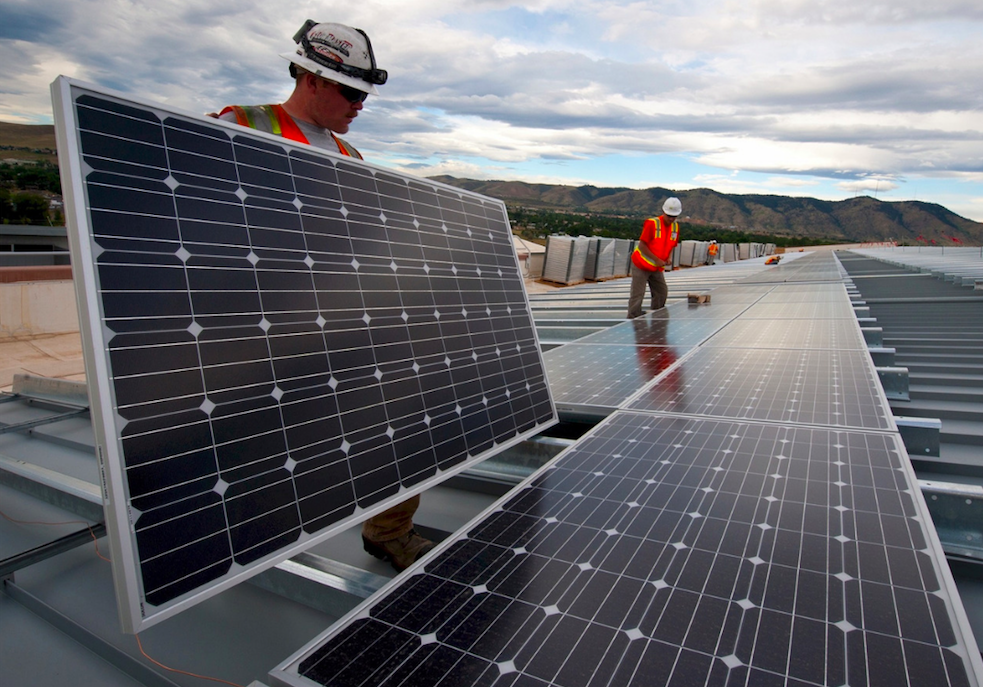 PxHere
PxHere
April 22, 2022, marks the 52nd anniversary of Earth Day, a now-global holiday that began as an environmental protest in 1970.
On the first Earth Day, inspired by the Santa Barbara oil spill of 1969 and other disasters caused by growing pollution in the U.S., 20 million Americans gathered in streets and parks to call for more environmental regulation. As Earth Day actions span the globe, environmental activists’ demands have grown to include jobs, education, and environmental justice.
It may surprise you to learn that you don’t need a degree in environmental science to fight climate change. Much of the work that must be done to make our country more sustainable will be accomplished by farmers, construction workers, and electricians—and much of that work is starting at the local level already.
Inspired by a list of green jobs in Data for Progress’ report, Stacker explains which occupations are on the front line against climate emergency. Read on to learn about everything from energy auditing to tree planting, and how you can get involved.
You may also like: 15 careers to make the ocean your office
![]()

Administrative support is a crucial, albeit often thankless, role in any industry. As climate change and sustainability become higher priorities in both the private and public sectors in the coming years, the roles of many administrative workers may change from traditional clerical duties to include more work with large-scale environmental data, communication, and grassroots organizing.

The Environmental Protection Agency (EPA) defines a brownfield as a property, once used for commercial or industrial purposes, which cannot easily be expanded, developed, or reused due to pollutants or other hazardous substances.
There are over 450,000 such properties in the U.S., ranging from large former factory sites to smaller abandoned gas stations. The EPA’s Brownfields Program started in 1995; it aims to help property owners and other stakeholders safely assess, clean, and redevelop their brownfields in a sustainable manner. This program has fostered the revitalization of more than 7,000 properties since its inception and has supported almost 150,000 administrative roles and manual labor jobs.
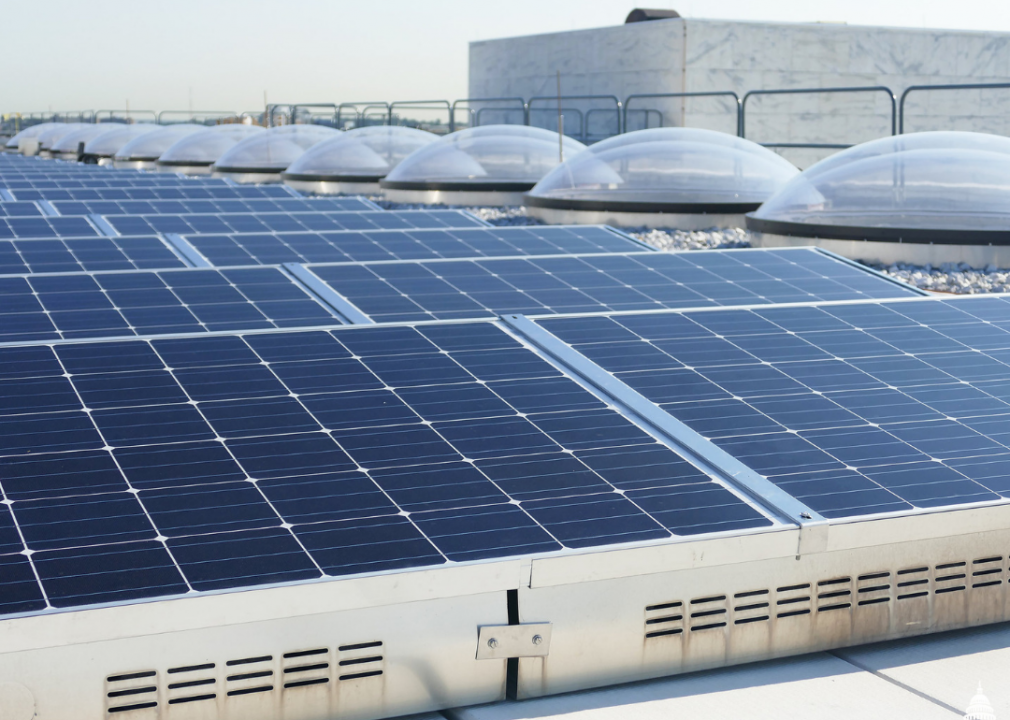
One way to reduce American reliance on fossil fuels is by building electrification. Workers are brought in to construct new buildings and convert old ones to be entirely reliant on electric sources, such as electric air source heat pumps and heat pump water heaters, which conserve energy and may increasingly be powered by renewable sources.
Several local governments across the country, including Marin County and Palo Alto in California, have updated their building ordinances to require electric power for new buildings. Such electrification requires electrical engineers, architects, and construction workers alike to gain expertise in sustainable heating technology.

Building rehabilitation, remediation, and hardening involve the preservation of old buildings to bring them up to modern health and sustainability standards. This may include removing dangerous substances that were used in previous construction efforts, such as asbestos, chlordane, lead, and polychlorinated biphenyls (or PCBs), organic compounds that cause a wide range of health problems in animals and humans.
Similar to building electrification, this job may require people with different levels of education or specialized expertise, from environmental specialists (who need at least a bachelor’s degree) to construction laborers.

For humanity to turn things around and protect the planet from the impending dangers of climate change, we must first collectively get on the same page about what those dangers entail.
To that end, science communicators have a key role in helping members of the public, from lawmakers to ordinary voters, understand how their communities are impacted by climate change and what they can do to help. Science communicators may start with a background in science, communication, or a combination of the two, and may work as journalists, for government agencies, or in other multimedia roles.
You may also like: 15 basic physics concepts to help you understand our world
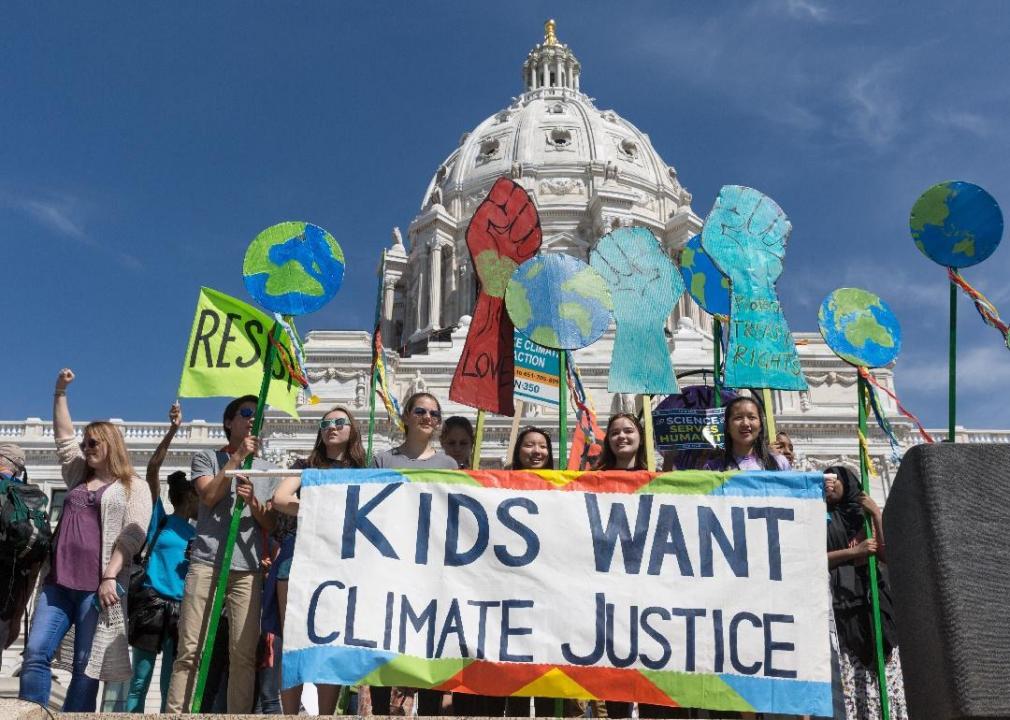
Similar to science communicators, community educators help fight climate change by providing people with the necessary knowledge and skills to get active in their own backyards. Community educators may work with schools, government agencies, activist groups, and other local institutions to lead workshops and other types of training events.
The Bureau of Labor Statistics predicts that job opportunities for this occupation, which usually require a bachelor’s degree, will grow by 18% from 2016 to 2026—much faster than the average.
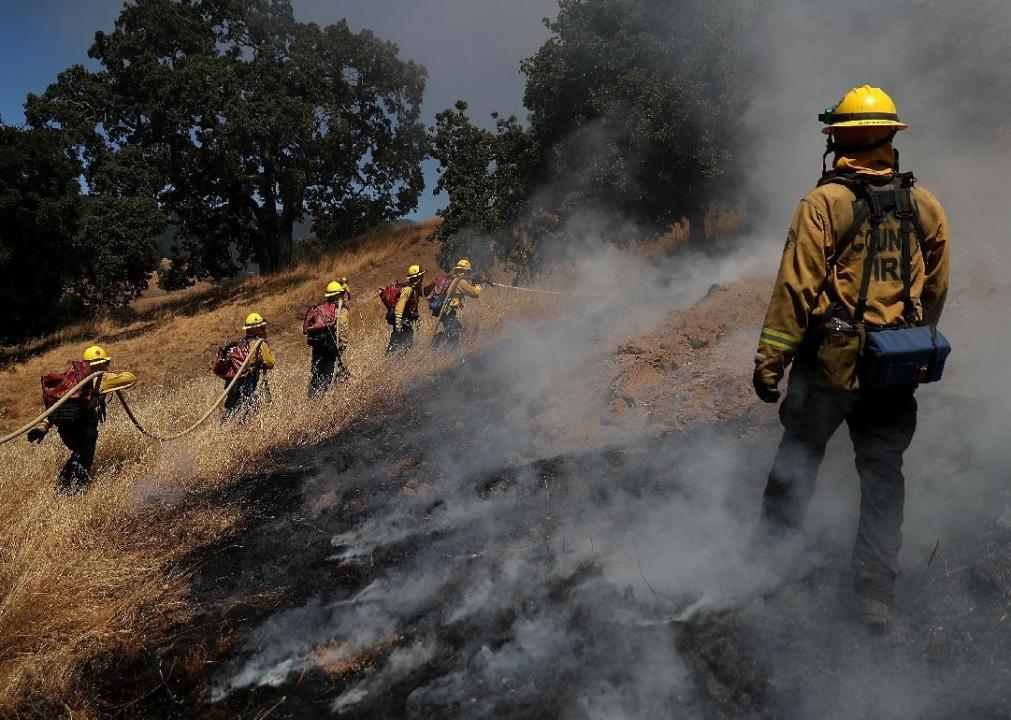
One inescapable impact of climate change is its effect on extreme weather: A March 2019 study by Carbon Brief suggests that 68% of all extreme weather events investigated to date, including heatwaves, droughts, and hurricanes, have been made more likely or more severe by human-caused climate change.
The field of emergency preparation must then grow in kind, to help the government and other public safety workers respond to emergencies as quickly and effectively as possible. And disaster preparedness doesn’t just apply to weather, either—climate change is also tied to more long-lasting natural disasters, such as disease epidemics, which can spread much more rapidly in our increasingly globalized world.
[Pictured: Firefighters train ahead of wildfire season.]
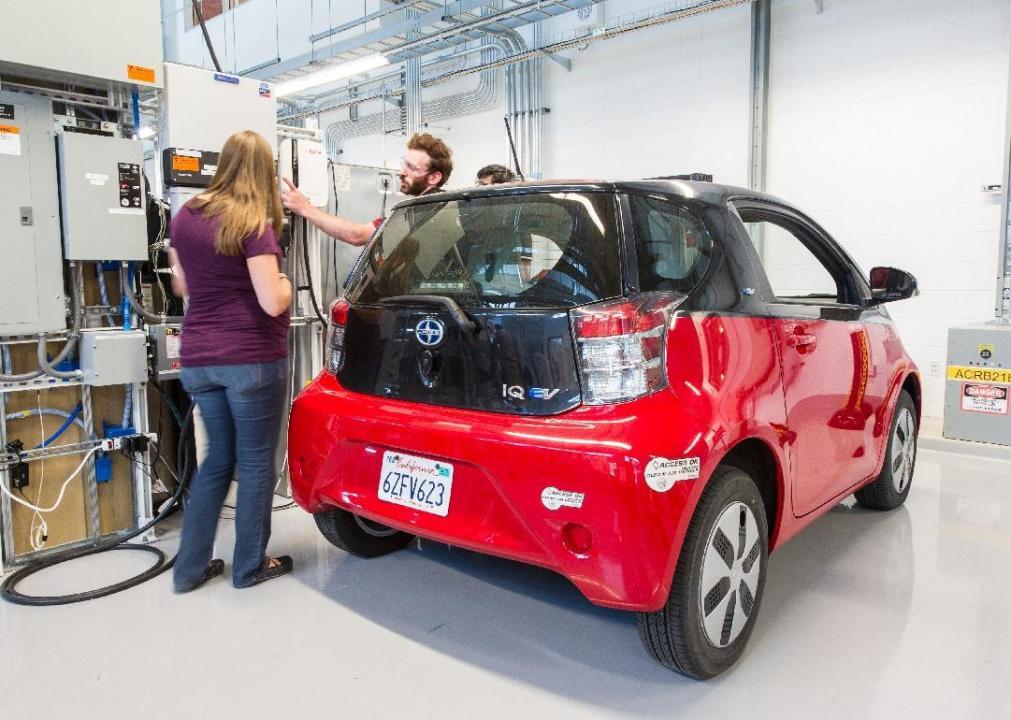
Electric cars and hybrids are becoming increasingly affordable: While Tesla’s first electric car, the Roadster, cost over $100,000 at its release in 2008, consumers may now purchase a Hyundai, Chevrolet, or Volkswagen model for a third of that price. Electric cars reduce pollution, save their owners money, and may now be charged at home or on the road. The automobile industry is also shifting to develop and rely on biofuels, or fuels made out of sustainable plant and animal materials, which cut down our reliance on oil.
[Pictured: National Renewable Energy Laboratory engineers work in electric vehicle supply equipment.]
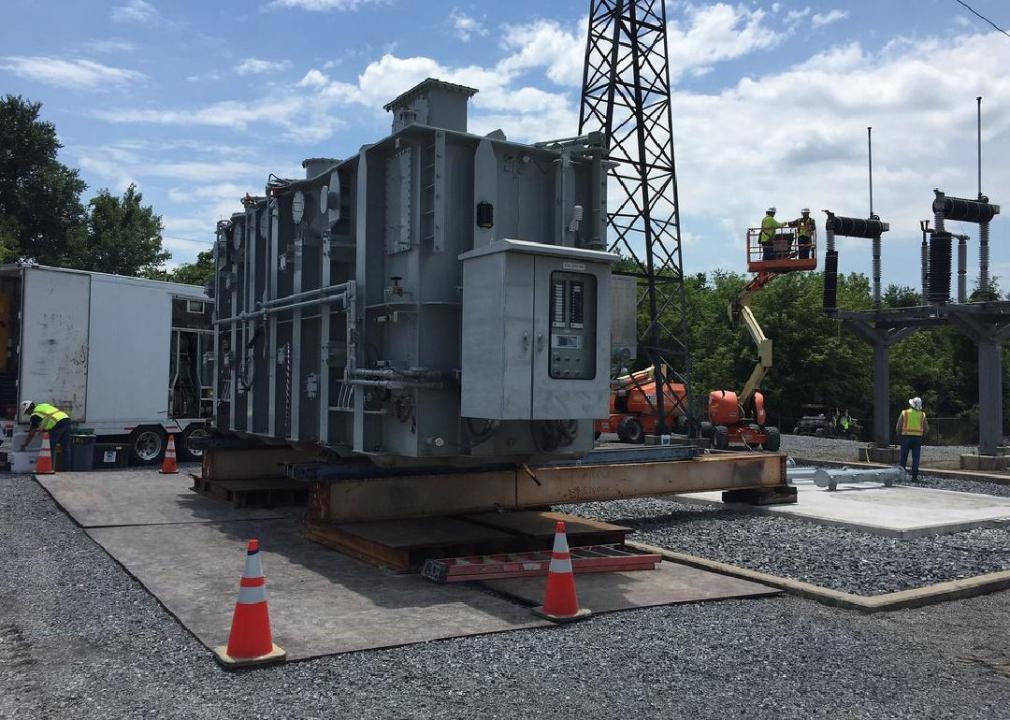
Energy auditing, similar to its financial counterpart, involves the official inspection and assessment of the energy that specific homes or other buildings are using. Professional energy auditors may conduct such an inspection by examining each room of a building, using equipment such as blower doors (to measure how airtight different rooms are) and infrared cameras (to detect hot and cold areas around doors, windows, and walls).
The U.S. Department of Energy recommends that homeowners conduct an energy audit before making energy-saving home improvements, such as installing solar panels or changing heating systems.
[Pictured: FirstEnergy Launches Grid Modernization Program in Pennsylvania.]
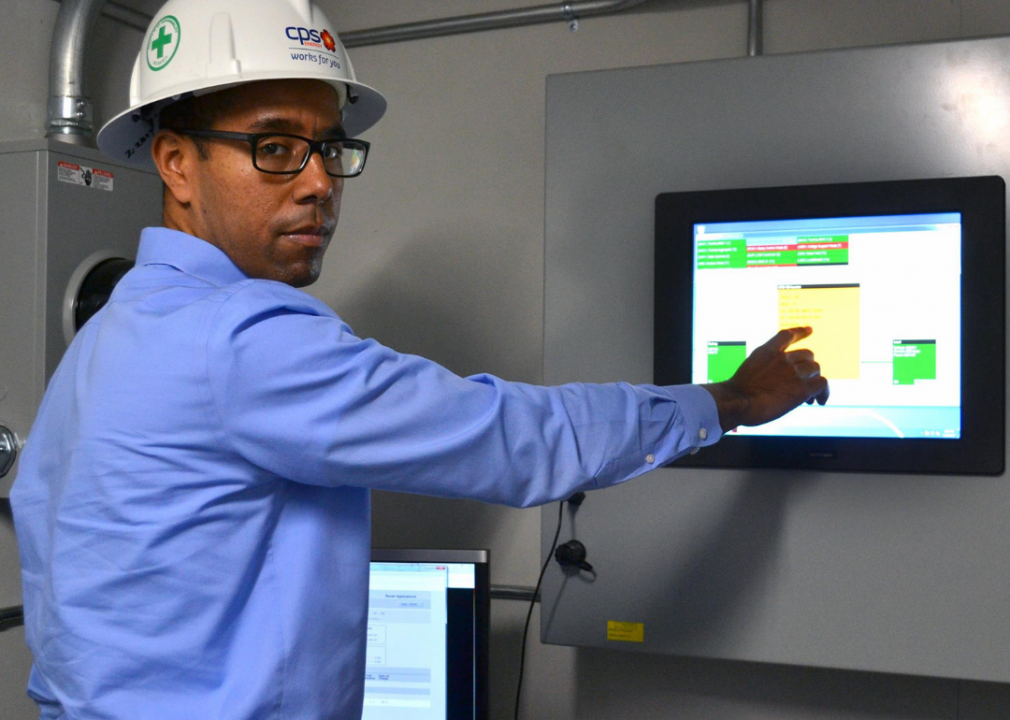
The U.S. electricity grid has the overall capacity to store about 23 gigawatts of energy: approximately the capacity of 38 typical coal plants, according to the Union of Concerned Scientists. This storage, which primarily relies on nuclear power, is currently serving us well: At night, when demand for electricity is low, the energy from nuclear power plants is built up and stored for high-demand hours the next day.
However, renewable energy sources such as solar and wind power produce energy at more variable rates; as a result, if our energy reliance shifts further toward these methods, expert engineers will need to increase our storage capacity. New energy storage methods currently under development include thermal storage, compressed air, and large-scale batteries.
You may also like: Can you answer these real ‘Jeopardy!’ questions about space?
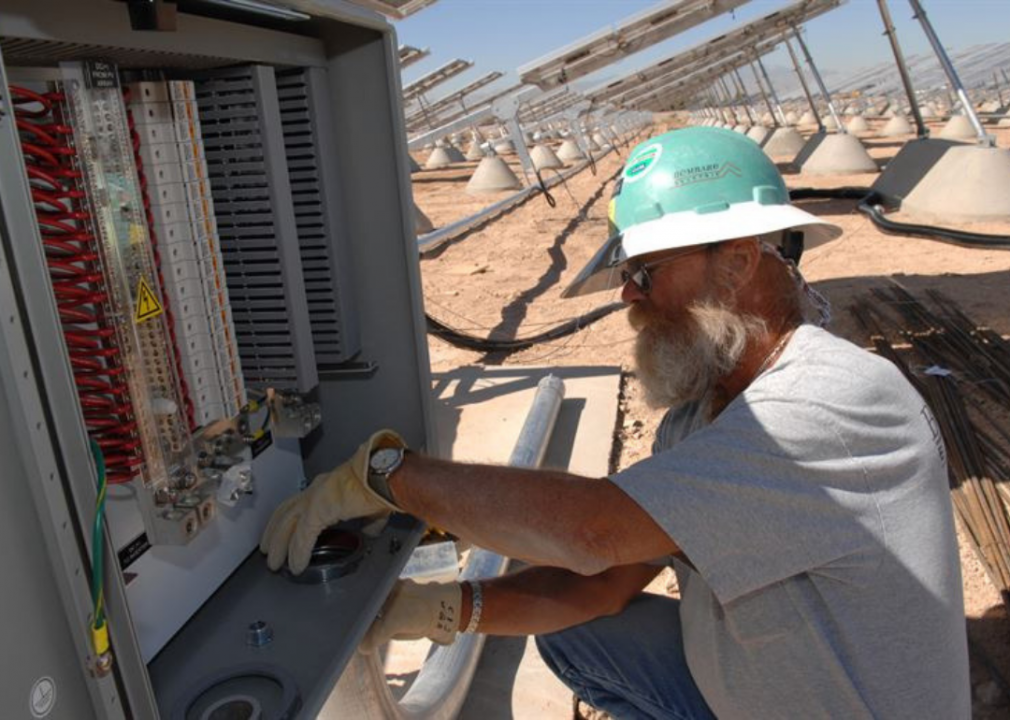
Just as U.S. energy storage technology needs to be updated to serve the needs of renewable energy sources, our national power grid will need to be updated so that energy can be efficiently and reliably distributed around the country. Although many of the technical aspects of grid modernization will fall on electrical engineers, this industry also has opportunities for people interested in communications and marketing.
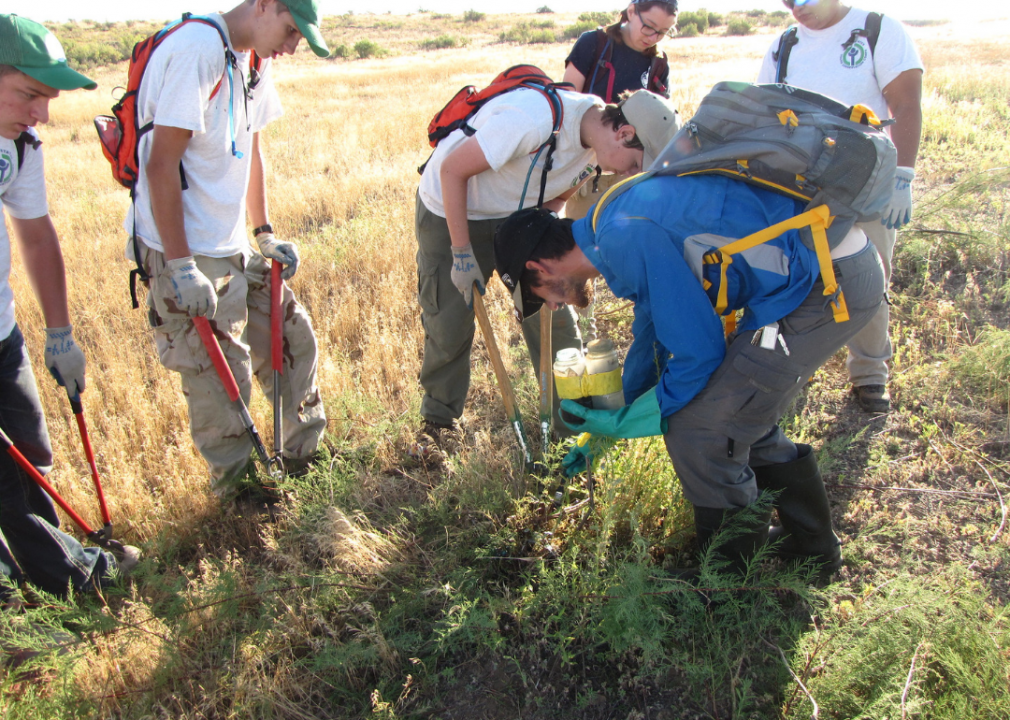
In ecology, the term “invasive” refers to an animal or plant species introduced to a region outside of its home range and has become a threat to naturally occurring wildlife or agricultural production in that new area.
In the U.S., particularly invasive species include the Chinese privet, a shrub that now dominates more than 1 million hectares of land across the southern U.S., and Burmese pythons, which threaten the birds, mammals, and even crocodiles in Florida. Wildlife experts in the National Parks Service and private organizations are coming up with increasingly creative measures to control the spread of invasive species; in New York City, for example, goat populations have been established in city parks to dispose of invasive plants.
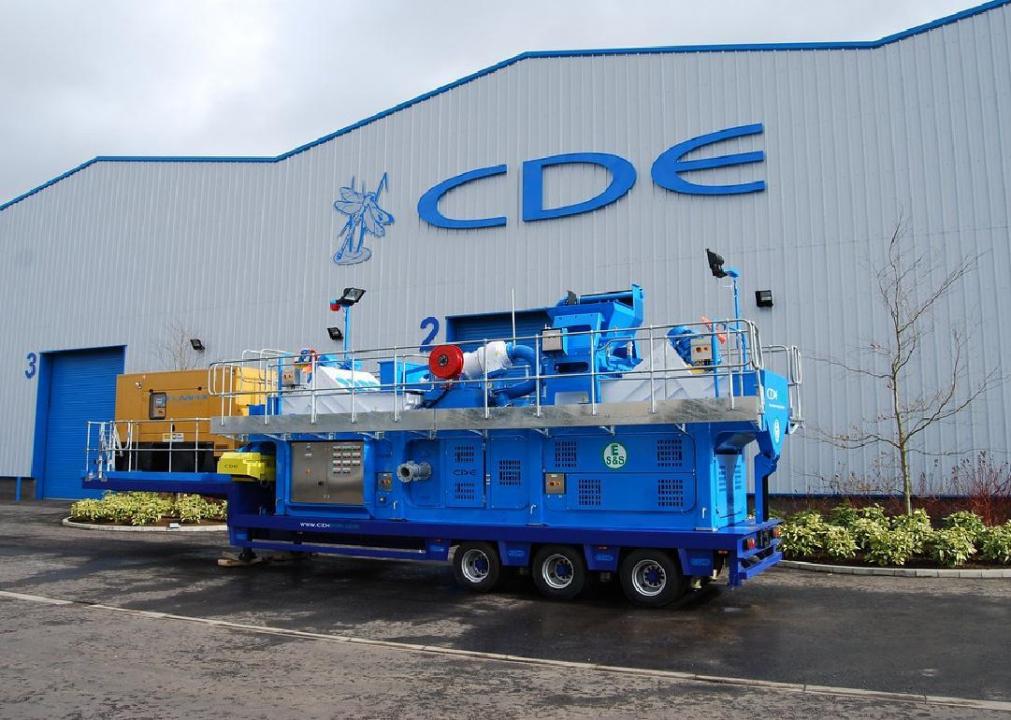
Landfills full of municipal solid waste are the third-largest source of human-related methane emissions in the U.S., according to the EPA. This methane doesn’t need to float up into the atmosphere as a dangerous greenhouse gas, though—a landfill gas treatment system installed over the trash site can clean and process the methane, allowing it to be reused as vehicle fuel or to produce electricity. As of February 2019, EPA engineers had helped transform more than 600 landfills with these eco-friendly treatment systems.
[Pictured: The DMax plant can process many materials and reduces waste to landfill volumes.]
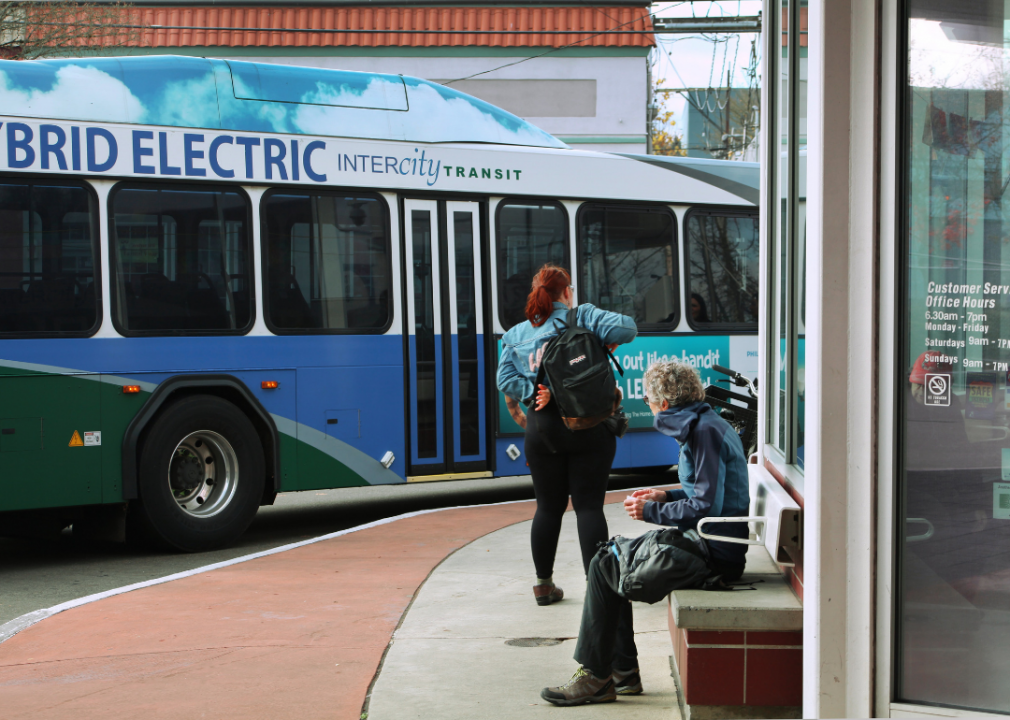
Just as buildings can be made more sustainable when they rely on electric power, so too can public transportation. Major cities around the world are electrifying their public transportation systems: For example, every five weeks, 9,500 electric buses are deployed in China, helping to combat the country’s problem with urban air pollution.
In addition to sustainability benefits, electric buses are more comfortable, as they generate less noise and vibrations than diesel buses. The U.S. is due to follow this trend as well; Bloomberg predicts 84% of the entire world’s buses will be electric by 2030.
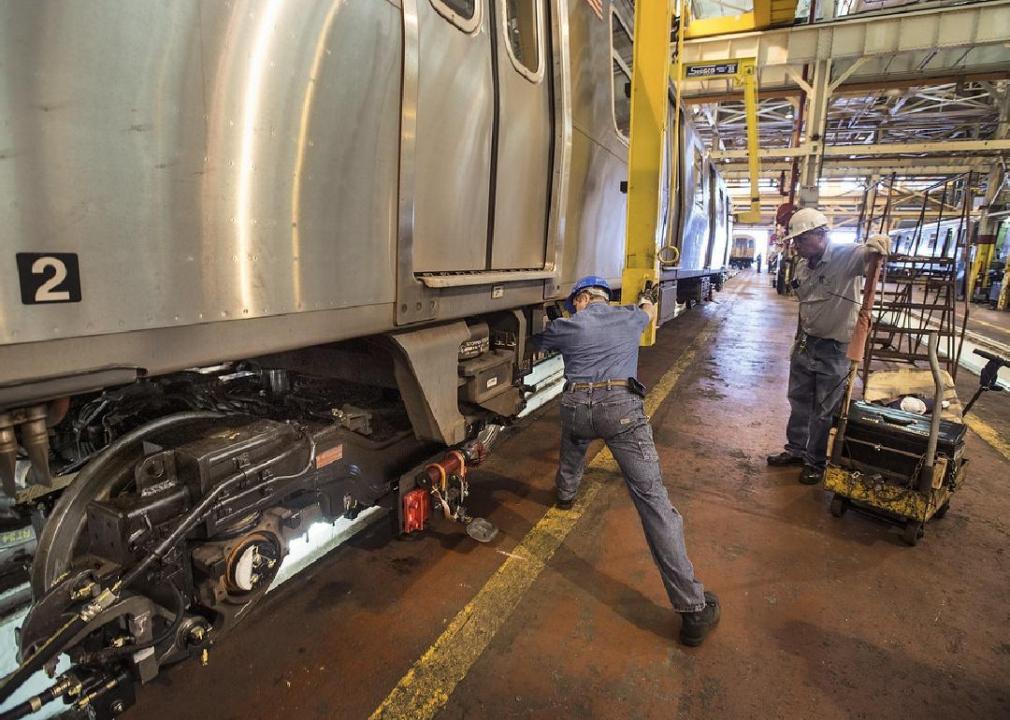
Repairing buses or performing maintenance on the subway may seem like a mundane job, but it is in fact vital to helping millions of Americans live more sustainable lifestyles.
Riding a subway system such as San Francisco’s BART to work emits about three times less carbon dioxide per mile than driving a standard sedan. Thus, everyone from the city planners who develop new subway lines to the drivers who remind you to ‘stand clear of the closing doors, please’ plays a role in reducing overall greenhouse gas emissions for urban communities.
You may also like: The only 7 countries that are on track to meet the Paris Agreement—and how they’re doing it
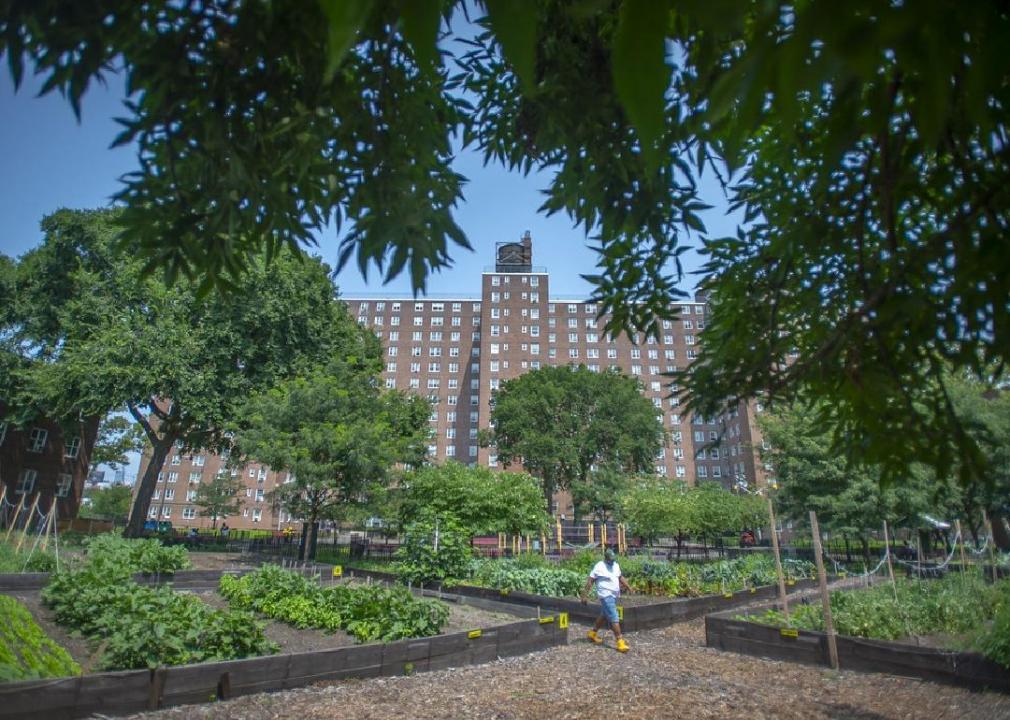
Green spaces such as parks and community gardens can combat the effects of climate change: Trees, grasses, and other vegetation clean carbon dioxide from the air and add nutrients to the soil, preventing runoff.
In cities, shaded areas and bodies of water in parks can help keep the air cool. And green spaces have been linked to a variety of health benefits, including better cardiovascular health, mental health, and opportunities for social contact. As a result, many American cities are developing new green spaces and improving upon old ones.
[Pictured: New York City Housing Authority gardens in Brooklyn.]
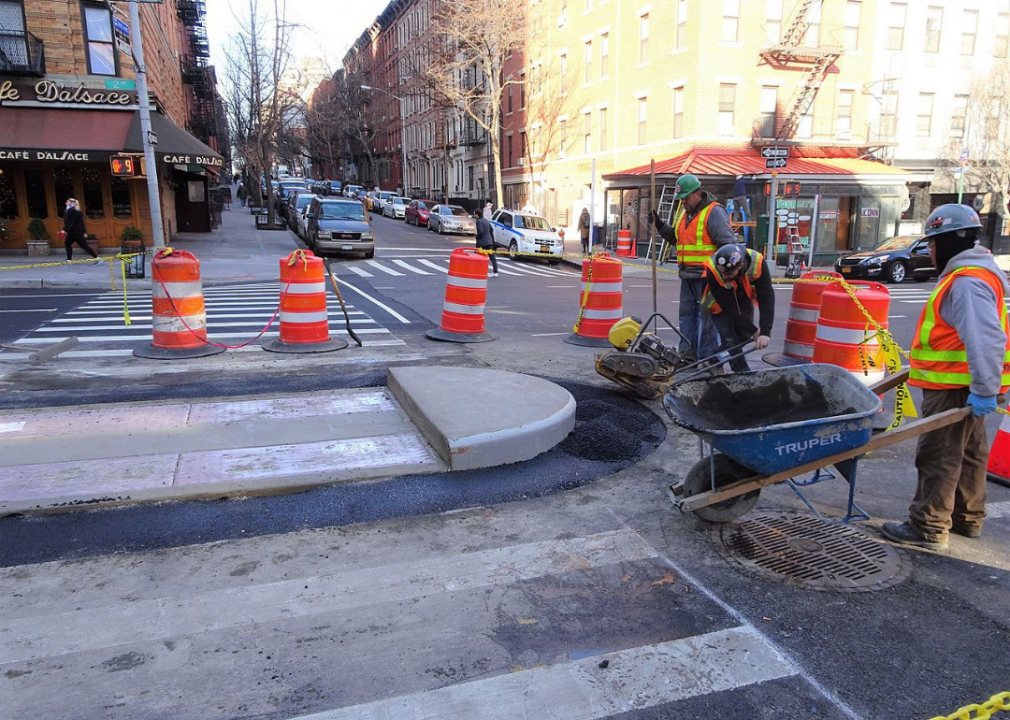
Taking public transportation is a great method to reduce your carbon footprint if it’s available—walking or biking to work is even better.
The city planners, local government workers, and construction workers who develop new pedestrian and bike lanes help Americans save gas and money: In one cost-benefit analysis, researchers found that planned investments in bike lanes in Portland, Oregon, could save the city’s residents more than $500 million in health care costs.
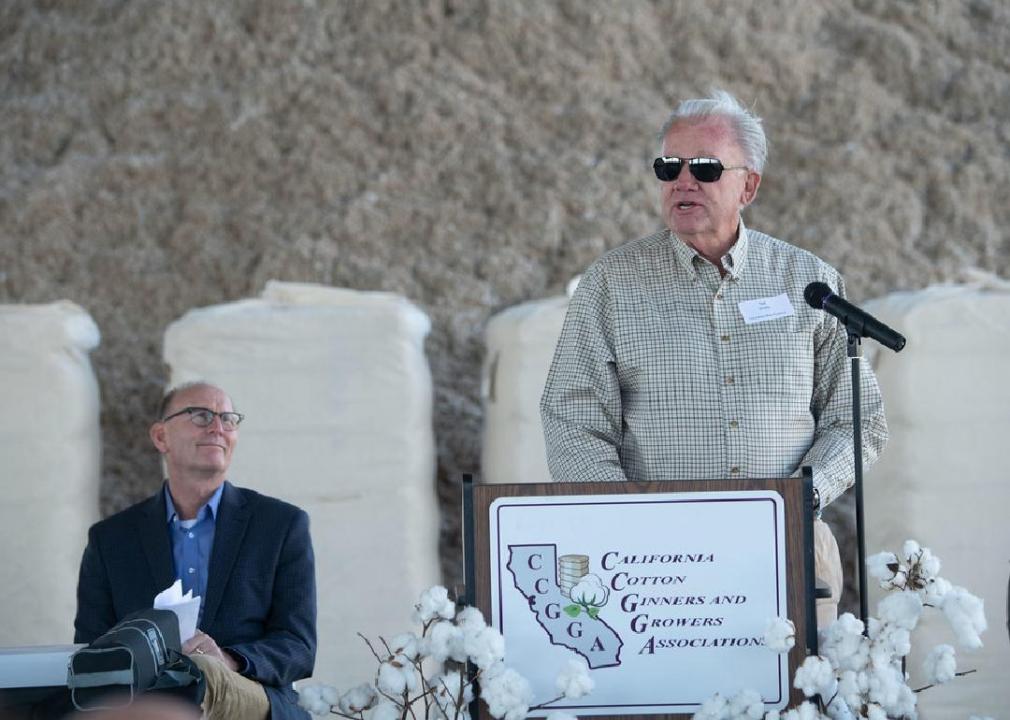
Pest control workers typically require a high school diploma and on-the-job training. Controlling the spread of locusts, beetles, rootworms, and other insects is becoming vitally important to agricultural production as rising temperatures enable these pests in reproducing more rapidly and widening their ranges. Agricultural scientists recommend that farmers and farm policy specialists look into new pest management strategies and new, more resilient genetically modified crops.
[Pictured: California Cotton Pest Control Board Chair Ted Sheely, in Lemoore, 2018.]

Public green space maintenance includes everything from botanist surveys of all the plants in New York City to snowplows clearing the paths of Central Park after a blizzard. Some of these maintenance jobs are entry-level, while others require specialized training in areas such as plumbing and horticulture. In addition, green space maintenance can be permanent or flexible: The National Parks Service offers seasonal park ranger opportunities for those who want to spend a summer in nature.
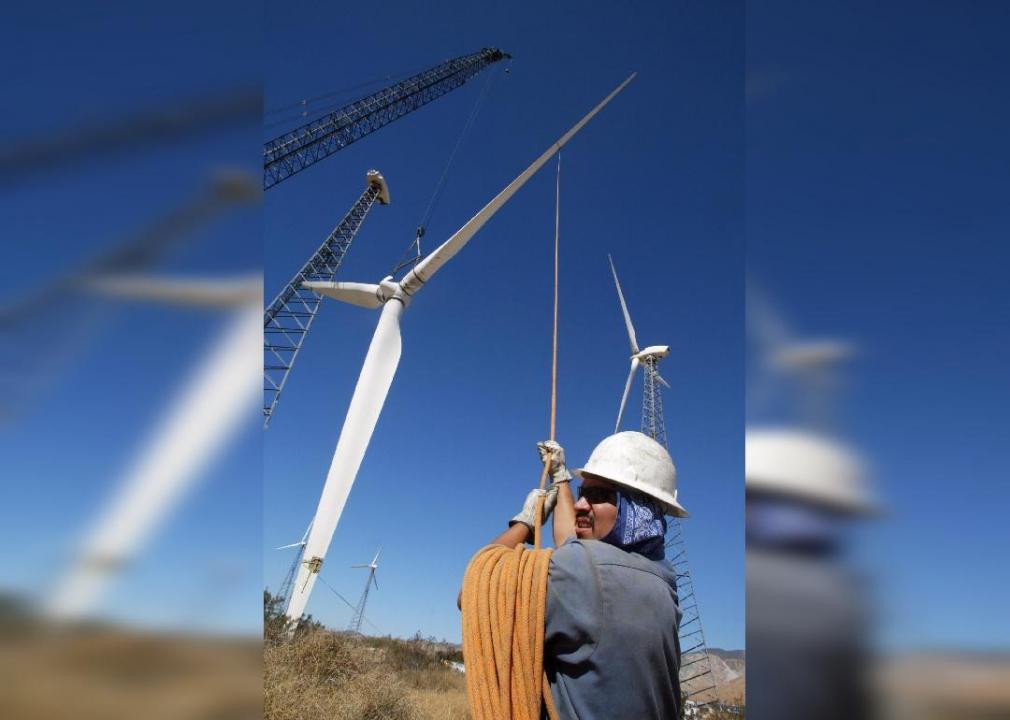
Rep. Alexandria Ocasio-Cortez and Sen. Ed Markey’s proposed Green New Deal called for all energy consumption to come from “clean, renewable, and zero-emission” sources by 2030; other politicians have proposed similar legislation. It is safe to say that engineers and technicians with expertise in solar panel installation, wind turbines, and geothermal energy will soon be in high demand. Jobs in solar energy, for example, grew by 159% from 2010 to 2018, according to the National Solar Foundation.
[Pictured: EnXco tag line crew member hoists a propeller up to the top of the windmill in Palm Springs, California.]
You may also like: 54 American cities with dangerous ozone conditions
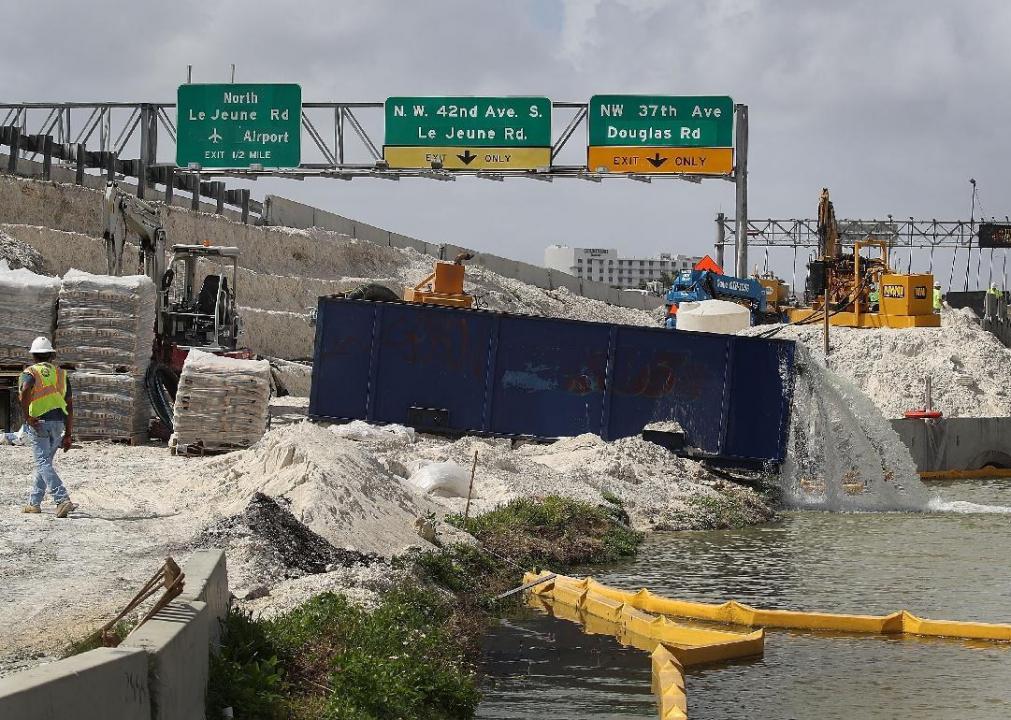
As climate change increases the frequency and severity of severe weather events, both highways and local roadways are more at risk of damage.
A week of severe rain and flooding in Colorado in September 2013, for example, destroyed or damaged nearly 500 miles of public roads, costing more than $500 million in damages. As a result, local governments are concerned with rebuilding old roads and constructing new roads to be more stable in the face of disaster; such construction involves collaboration between government officials, other landowners, engineers, hydrologists, and construction workers.
[Pictured: Construction workers build along State Road 836 in Miami, Florida.]
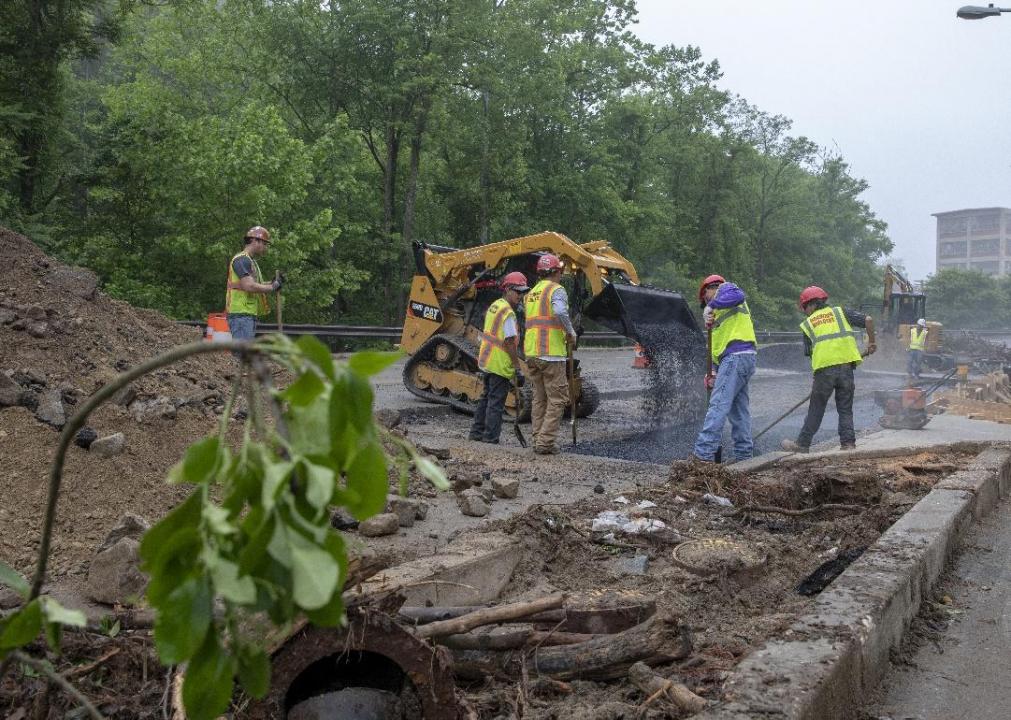
Extreme weather events such as severe rainstorms don’t only damage roads; they also cause sewer systems to overflow, releasing millions of gallons of untreated sewage water into homes and businesses.
For instance, 681 million gallons of sewage were released in April 2015 in Milwaukee after only three days of rain. In order to prepare for such flooding, some cities are employing engineers and hydrologists to design more resilient sewer systems. New York City in January 2019 invested $28 million in a new project to install new storm sewers, sanitary sewers, water mains, catch basins, and wetland protection systems on Staten Island.
[Pictured: A work crew attempts to repair the road and clear drains in Ellicott City, Maryland, 2018.]
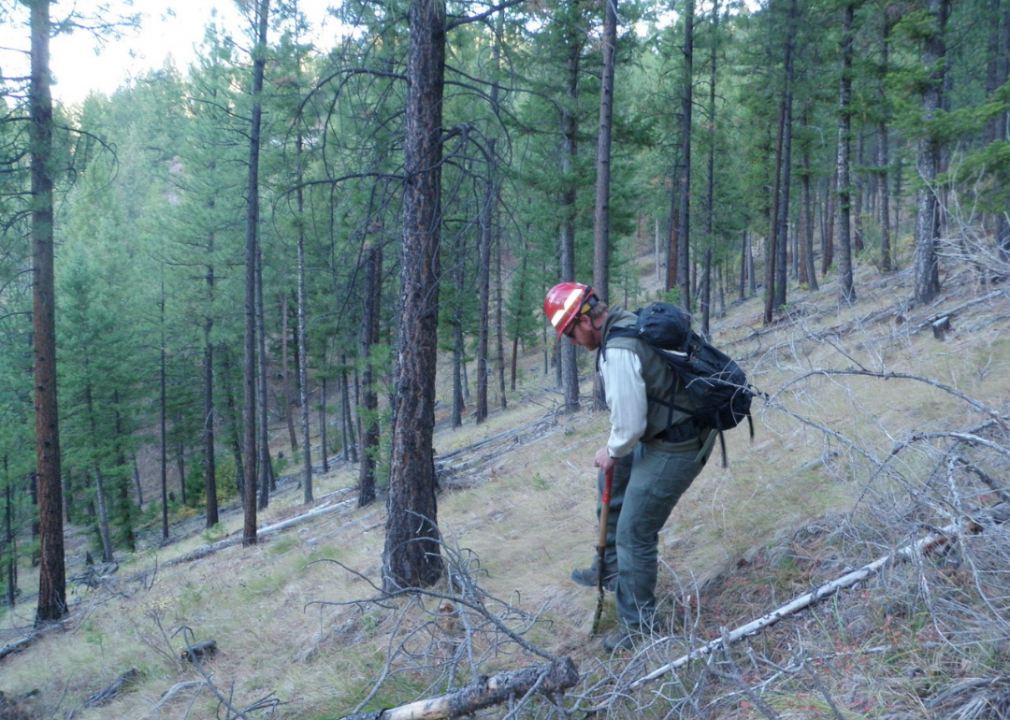
We usually think of the atmosphere as the primary source of carbon on Earth, but that’s a myth: The Earth’s soils contain two to three times more of this vital element. Yet one-third of these soils have been damaged by poor farming practices, industry, and urbanization.
Testing the health of and putting carbon back into our soils is thus a key strategy for revitalizing the planet, Dr. Cornelia Rumpel of the French National Centre for Scientific Research and several colleagues argued in a December 2018 Nature article. These scientists suggest protecting peatlands (which have high soil carbon), promoting carbon intake in soils through better farming strategies, and monitoring soils more closely year-round.
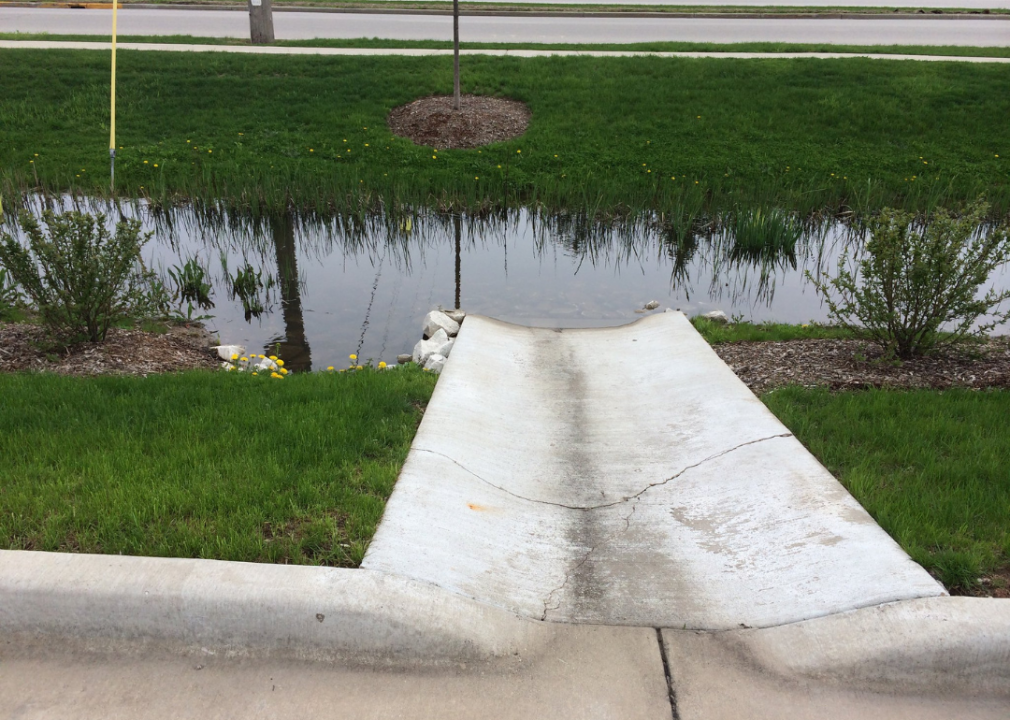
Upgrading and maintaining city-wide sewers is not the only task involved in keeping polluted water from seeping into streets and soils. In fact, the environmental consulting firm EEC Environmental recommends every homeowner takes time to investigate where rainwater and stormwater flow on their property in order to make construction or landscaping adjustments to reduce runoff and protect their land. Environmental consultants, as well as developers and contractors, may be involved in this work.
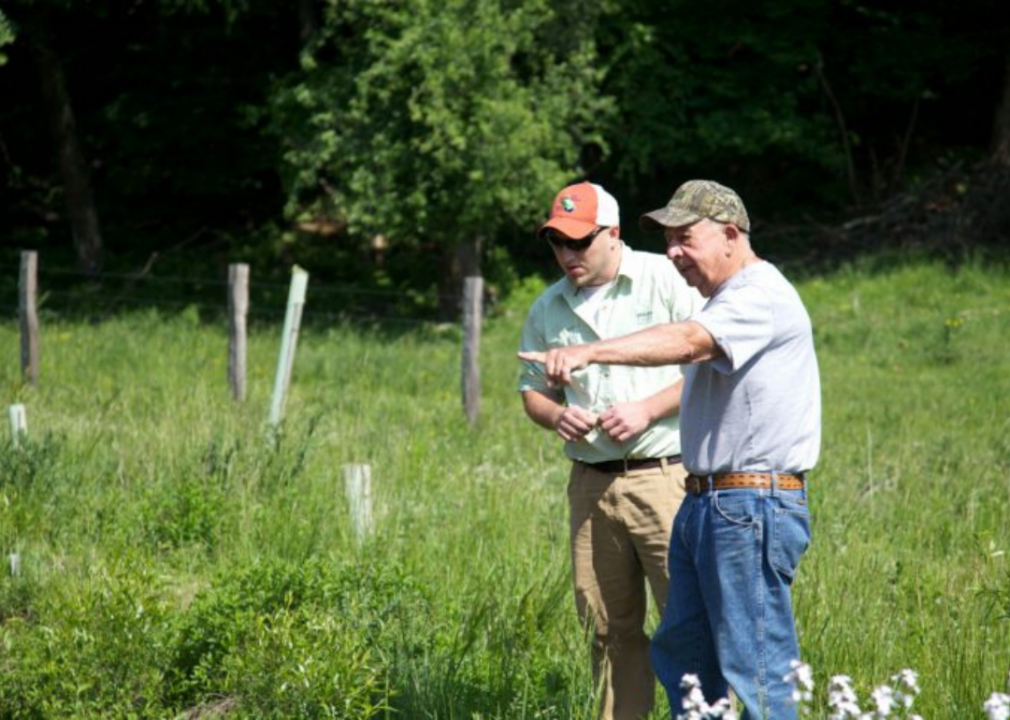
The Great Plains in the 1930s—after about a decade of intense, mechanized farming techniques—was struck by an intense period of drought, crop failure, and economic depression known as the Dust Bowl, which stands as one of the worst ecological disasters in human history.
Today, many farmers and agricultural scientists work to ensure a disaster like the Dust Bowl never happens again through more sustainable farming practices. These sustainable techniques include growing multiple crops in the same area to increase soil nutrients, planting cover crops (like clover and hairy vetch) during the off-season, and integrating livestock with crops to create more ecologically natural environments for plants and animals.
You may also like: Rare animals featured in ‘Planet Earth,’ ‘Our Planet,’ and other nature documentaries
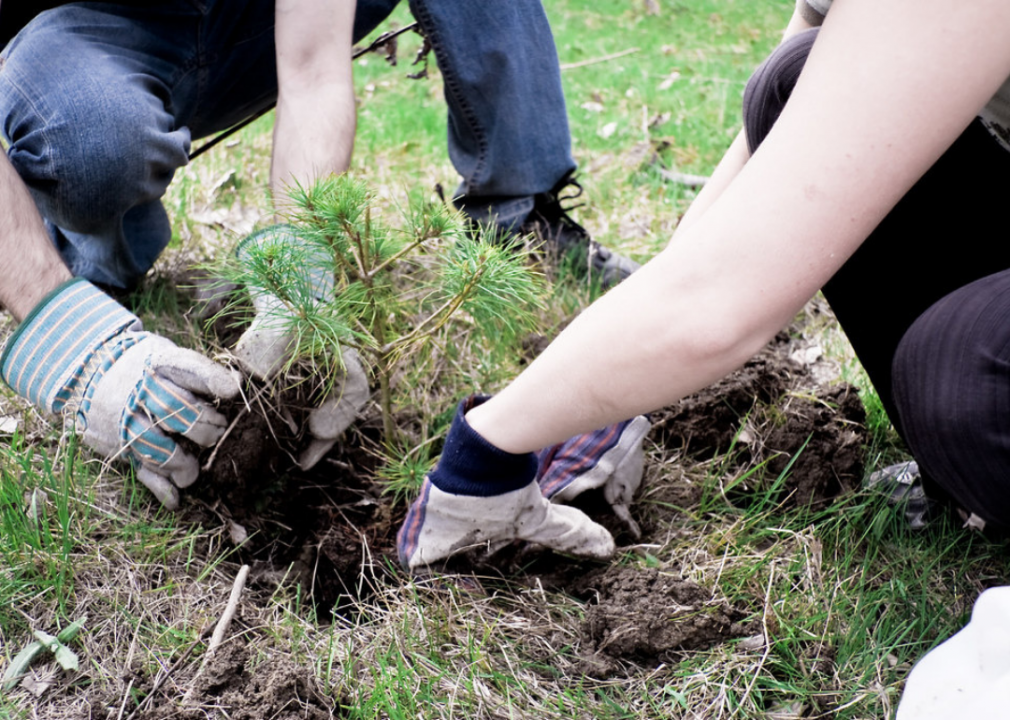
Tree planting is perhaps the job on this list that requires the least amount of expertise: Anyone can buy a sapling, plant it in their backyard, and help it grow. But this small task, if multiplied on a grand scale, can transform urban and rural neighborhoods alike, as trees filter pollutants from the air, provide habitats and food for other plants and animals, and even save energy by insulating buildings.
Some cities are mobilizing their citizens to plant and take care of trees in their neighborhoods: In 2016, New York City completed its initiative to plant 1 million trees across the city.
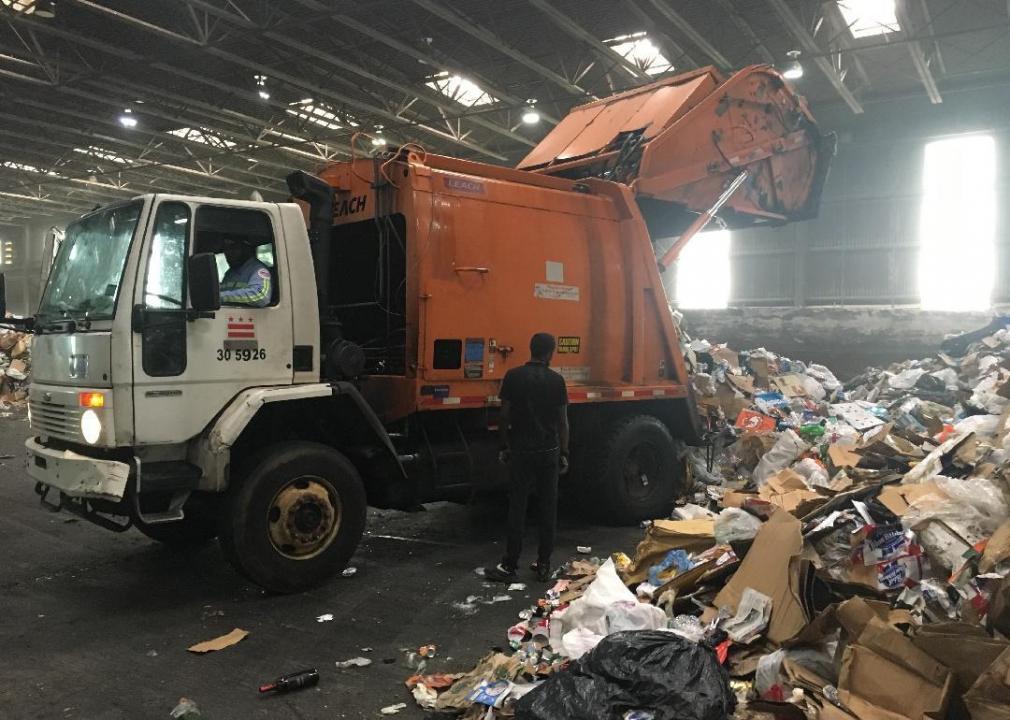
Recycling has become fairly ubiquitous in American culture: Many people are used to separating out paper from plastic and checking for little triangular symbols on the bottoms of containers. In 2018, the U.S. recycled and composted a total of 94 million tons of municipal solid waste, according to the EPA: That’s a lot of job opportunities—collecting, sorting, processing, and recycling 94 million tons of waste is no easy feat, especially after China stopped importing several key American recyclables.
[Pictured: Trucks deliver trash and recycling waste at the Fort Totten Transfer Station in Washington D.C.]
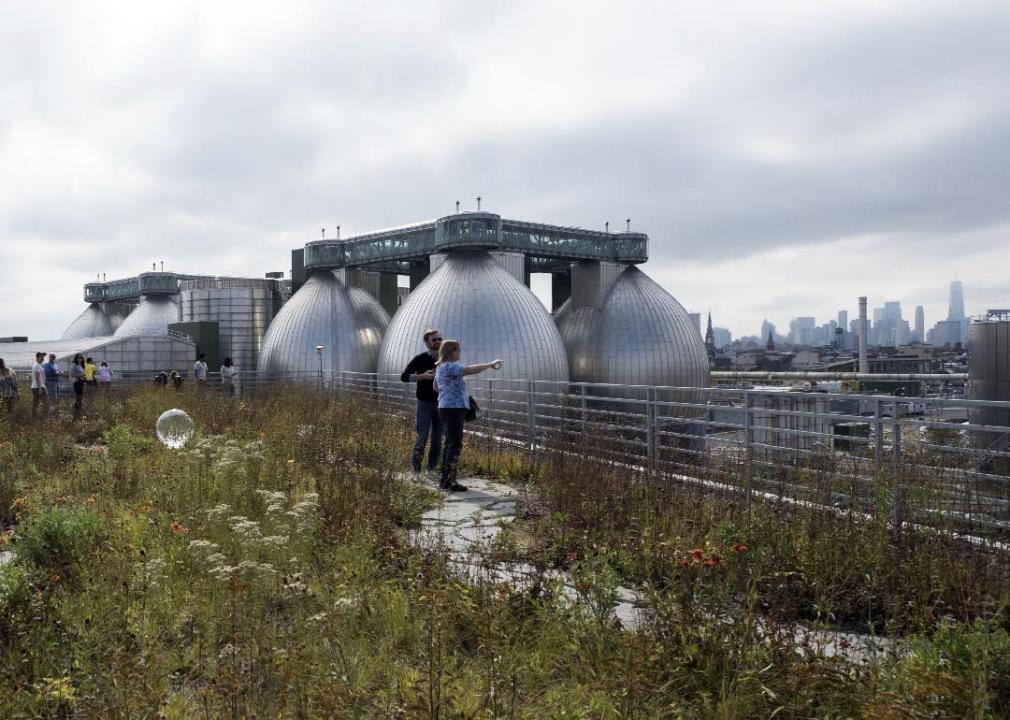
Communities from Flint, Michigan, to Pittsburgh to Brady, Texas, have been exposed to hazardous compounds in their tap water, many of which enter water systems through accidental chemical spills, sewage runoff, and atmospheric deposition. Scientists, engineers, and machinery operators alike play roles in addressing these water quality issue. A high school diploma is usually required to become a water and wastewater treatment plant and system operator.
[Pictured: Kingsland Wildflowers Green Roof with Newtown Creek Wastewater Treatment Plant, New York.]
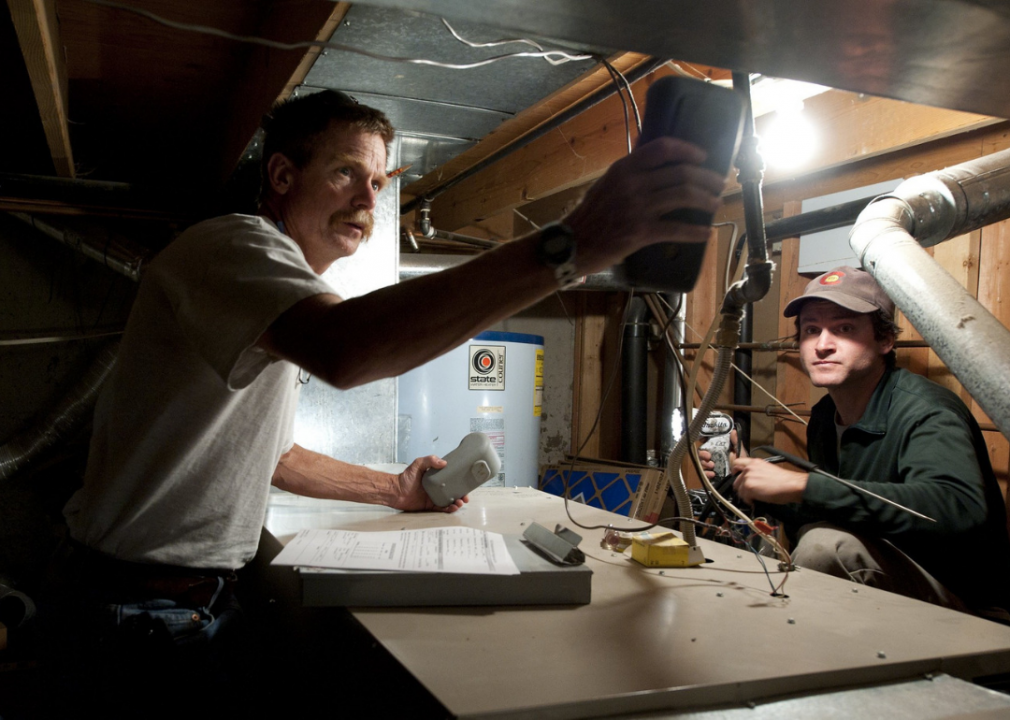
Weatherization is a common practice in modern construction; the term refers to a variety of home improvements that protect buildings from sunlight, precipitation, and wind. After performing an energy audit, you can hire an expert or engage in some do-it-yourself remodeling to weatherize your home through reducing air leaks, controlling moisture, regulating ventilation, and other techniques.
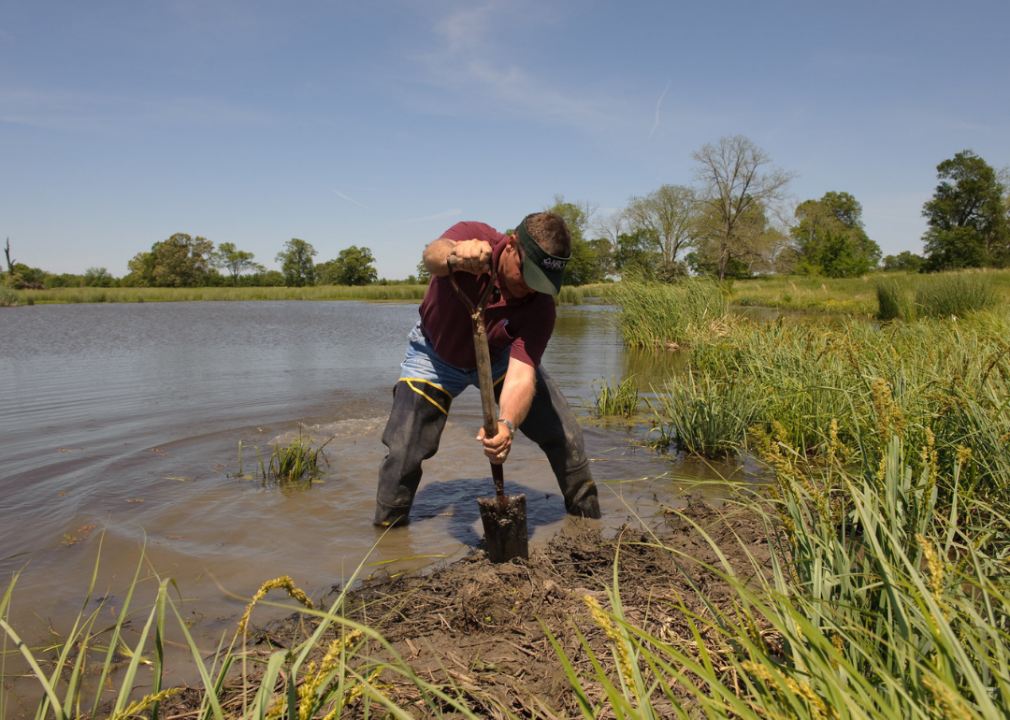
You’ve likely been to a wetland, even if you don’t know it: This category includes marshes, mudflats, swamps, river basins, and bogs—basically any land area that’s covered by water for most of the year. Many wetlands are priority areas for conservation because they act as natural buffers, absorbing floodwater from tropical storms and hurricanes.
American wetlands are also home to many endangered plants and animals, such as the bald eagle, whooping crane, and swamp rose. Ecologists, environmental scientists, parks workers, and environmental policy experts are all involved in studying and protecting America’s wetlands.
You may also like: Can you solve these real ‘Jeopardy!’ clues about the Earth?

Comments
Post a Comment
If you have any doubt, please let me know....